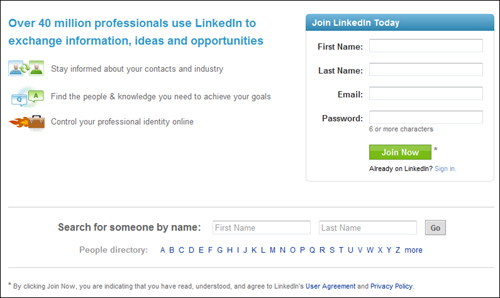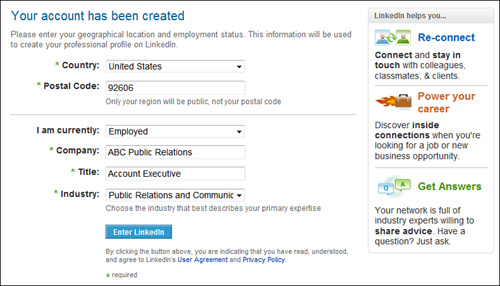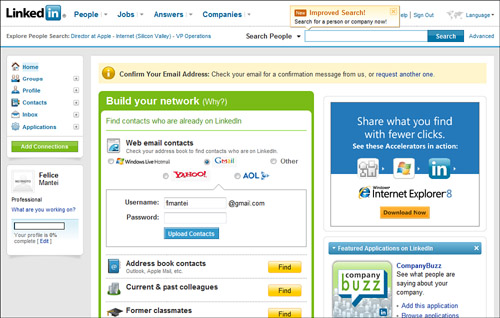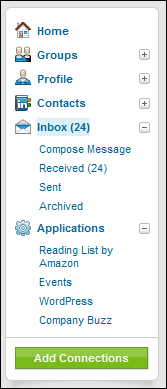In this lesson, you’ll learn the basics of LinkedIn and develop a strategy for success with this popular social networking site.
LinkedIn (www.linkedin.com) is the world’s leading social networking site for business, with profiles of more than 40 million professionals around the world. LinkedIn is also rapidly expanding: A new member joins approximately every second. The site is extremely active with recruiters from recruiting firms as well as from major companies such as Microsoft, eBay, and L’Oréal, which makes it a prime hunting ground for job seekers.
Everyone from top CEOs to President Barack Obama has a LinkedIn profile. If you want to network for business on just one social networking site, LinkedIn is the site to choose.
Note: LinkedIn History
LinkedIn was founded in May 2003 when the five company founders invited 300 of their closest business contacts to join. By the end of that first year, LinkedIn had reached 81,000 members.
With LinkedIn, you can
• Create a profile that helps achieve your professional goals
• Develop and manage a network of professional contacts
• Reconnect with former colleagues and classmates
• Find jobs, consulting opportunities, and clients
• Recruit job candidates
• Request and give professional recommendations
• Find and give answers to compelling business questions
• Join groups to discuss issues with like-minded individuals
• Establish your credibility as an expert in your field
• Conduct marketing research
• Promote your services as a LinkedIn service provider
• Advertise your business
Tip: Focus on Strategy, Not Filling Out Forms
At first glance, LinkedIn appears deceptively simple. Its true power, however, comes from employing the strategic best practices of online networking, not on your ability to enter your professional data in a form.
The key to success on LinkedIn is to establish clear goals and ensure that all your actions on the site work to achieve these goals.
For example, if your goal is to find a job on LinkedIn, you want to create a strong profile with keywords that attract recruiters. You also want to develop a solid network of professional contacts in your industry—the type of people who might hire you or who might provide relevant job leads.
On the other hand, if your goal is to find business leads and develop your platform as an expert in your field, you could use a different approach. A strong profile and network are still important, but you might also want to participate in LinkedIn Answers and LinkedIn Groups to promote your expertise among LinkedIn’s 40 million members.
Before establishing your goals, however, you need to understand the unwritten rules of LinkedIn. LinkedIn’s focus is on developing a mutually beneficial online business network. With LinkedIn, you can stay in touch with your existing contacts and connect with other professionals who share your goals and interests. LinkedIn is not the place to amass thousands of “followers,” engage in heavy sales tactics, or send spam-like communications. Keeping these “rules” in mind will help you develop a LinkedIn strategy that generates positive results in your professional career.
LinkedIn offers several account types, including a free personal account and three types of premium accounts. All accounts offer the ability to create a professional profile, develop a network of contacts, search for jobs and people, receive unlimited InMail and requests for introductions, participate in groups, and participate in LinkedIn Answers.
See Lesson 6, “Communicating with Other LinkedIn Members,” for more information about messages, InMail, and introductions.
With a free Personal Account, you can request a maximum of five introductions at one time, view 100 results per search, and save a maximum of three searches with weekly email alerts.
Note: LinkedIn Is a Powerful Search Tool
You can perform and save targeted searches for people, jobs, companies, and other LinkedIn content. See Lesson 7, “Searching on LinkedIn,” for more information about LinkedIn search capabilities.
LinkedIn’s free account offers so many powerful features that it should suit the needs of most users. Unless you specifically need a premium feature, try out the free account first before making the decision to upgrade.
Premium accounts offer you the ability to contact more people who aren’t connected to you and are ideally suited to recruiters or people using LinkedIn as a business development tool.
LinkedIn’s premium accounts enable you to
• Perform unlimited one-click reference searches
• Receive an OpenLink Network membership
• Send unlimited OpenLink messages
• Receive LinkedIn customer service responses within one business day
Your choice of the specific premium account that’s right for you depends on your needs for InMail, introductions, and searches.
The Business Account costs US $24.95 per month. With this account, you can
• Send three InMails per month, rolling over a maximum of nine unused InMails to the next month
• Save five searches and receive weekly alerts on each
• Maintain 15 pending introductions at one time
• View 300 results per search
The Business Plus Account is priced at US $49.95 per month. With this account, you can
• Send 10 InMails per month, rolling over a maximum of 30 unused InMails to the next month
• Save 7 searches and receive weekly alerts on each
• Maintain 25 pending introductions at one time
• View 500 results per search
The Pro account, at $499.95 per month, might interest power users. Pro users can
• Send 50 InMails per month, rolling over a maximum of 150 unused InMails to the next month
• Save 10 searches and receive daily alerts on each
• Maintain 40 pending introductions at one time
• View 700 results per search
Note: Get More with LinkedIn Talent Advantage
If you need a higher volume of InMails and introductions than the available premium accounts offer, consider signing up for LinkedIn Talent Advantage (talent.linkedin.com), a suite of power solutions for recruiters.
Signing up for a LinkedIn account is a simple, straightforward task. Figure 1.1 shows the welcome screen that greets you the first time you visit LinkedIn (www.linkedin.com).
To create your own LinkedIn account, follow these steps:
- In the Join LinkedIn Today box, enter your first and last names, email address, and a password. Be sure to create a strong password. A password that contains a combination of uppercase and lowercase letters, numbers, and symbols provides the most protection.
- Click the Join Now button. The Your Account Has Been Created page appears, shown in Figure 1.2.
- Enter your Country and Postal Code. Note that LinkedIn will display only your geographic region, such as San Francisco Bay Area, and not your actual postal code or city on your profile.
- In the I Am Currently field, select your employment status from the options available. For example, you can specify that you’re employed, a business owner, looking for work, and so forth.
- Enter your Company. As you start typing, LinkedIn locates potential company matches from existing profiles. Choosing from an existing entry helps ensure that you and your colleagues are correctly linked by company.
- Select the Industry that best describes your professional expertise from a list of more than 100 options. These options range from popular professions (Accounting, Banking, Computer Software, Internet, Real Estate, and Marketing) to the more obscure (Dairy, Gambling & Casinos, Fishery, and Think Tanks).
- Click the Enter LinkedIn button to open your LinkedIn home page. A sample home page is shown in Figure 1.3.
At the top of your home page, LinkedIn prompts you to confirm your email address. As a security measure, LinkedIn sends a confirmation message to the email address you entered when you signed up for an account. Click the link in this message to confirm. This ensures that the person who actually owns an email account signed up for LinkedIn and not someone else.
Tip: Your Confirmation May Be in Your Junk Mail Folder
If you don’t receive a confirmation message from LinkedIn, check your spam or junk mail folder. Alternatively, click the Request Another One link in the Confirm Your Email Address box on your LinkedIn home page to resend the confirmation.
When you first sign up, the Build Your Network box (refer to Figure 1.3) on your home page encourages you to start connecting with your existing contacts. However, I recommend that you create your profile before completing this step. Why? Because when your contacts receive your connection request, you want them to view a complete profile, not an empty one.
See Lesson 2, “Creating Your Profile,” for more information on creating your own profile. See Lesson 3, “Adding and Managing Connections,” for more information on building your LinkedIn network.
Now that you have a LinkedIn account, click the Sign In link whenever you visit the site to log on again with your primary email address and password. If you forget your password, click the Forgot Password? link on the Sign in to LinkedIn page to request a new one. If you always use the same computer to access LinkedIn, such as a home computer, you can remain logged in for up to 24 hours as a convenience.
When you first sign up for LinkedIn, you receive a personal account. To upgrade a personal account to a premium account, click the Upgrade Your Account link on the bottom navigation menu.
Your home page appears when you log on to LinkedIn. Figure 1.3 shows a sample home page, which is the dashboard of your LinkedIn activity. The content on your home page is dynamic and is unique to your LinkedIn actions, network, and account settings.
When you first create a LinkedIn account, your home page displays the Build Your Network box. After you create a profile and develop a network of more than 20 connections, however, LinkedIn allows you to close this box by clicking the Close (x) button that appears in the upper-right corner.
The center column of your home page includes the following content:
• Inbox. Displays a preview of your inbox with links to the five most recent unread messages. If you don’t have at least five unread messages, the preview displays the number of unread messages that are available. See Lesson 6 for more information about your inbox.
• Network Updates. Displays your current status and a text box for updating your status. See Lesson 5, “Managing and Updating Your Profile,” for more information about status updates. This section also lists recent updates from your connections.
Tip: View Your Network Updates as an RSS Feed
Click the orange feed icon next to the Network Updates heading to open the LinkedIn RSS Feeds page where you can subscribe to your LinkedIn network updates and read them in a feed reader. See Lesson 4, “Customizing Your LinkedIn Settings,” for more information on RSS and feeds.
• Group Updates. Displays recent group updates, including information about the groups your connections joined and comments and recommendations from fellow group members.
• News. Displays recent news articles about your company, competitors, and industry. You can also participate in discussions with your colleagues about news articles, recommend news to your colleagues, share news with your connections, or submit your own articles.
Note: Where Is the News Section?
The News section appears on your home page only if news is available for your current employer. If you’re self-employed or work for a small company, this section might not appear on your home page.
• Just Joined LinkedIn. Displays links to new colleagues and classmates who have joined LinkedIn recently.
Tip: Customize Your Home Page for Easier Viewing
To customize the network updates that appear on your home page, click the Account & Settings link in the top navigation menu and click the Network Updates link to open the Network Updates page.
The right column of your home page displays
• A list of three people you might know based on your existing connections. You can click the Invite link to the right of their name to send an invitation to connect. If you haven’t added any connections yet on LinkedIn, this option won’t appear.
• An advertisement.
• The Who’s Viewed My Profile? box. Click the See More link to learn more about the people who have viewed your profile. If you haven’t created a profile yet or no one has viewed your profile, this option won’t appear.
• Boxes for LinkedIn applications and features, such as Events, LinkedIn Answers, Jobs, and Amazon Reading List recommendations. LinkedIn uses the information from your profile to determine relevant content to display. For example, if you select Marketing as your industry, the content displayed should be useful to a marketing professional. See Lesson 13, “Using LinkedIn Applications,” to learn more about LinkedIn applications.
Tip: Customize the Applications that Appear on Your Home Page
To remove a box that displays in this column, click the X button in the upper-right corner of the box. Some boxes include an Edit link that you can click to customize the data that appears. To add application boxes, click the Add an Application button at the bottom of the column to select from the available options.
Navigating LinkedIn is a straightforward process once you understand its navigational structure. LinkedIn pages display three navigation menus: one at the top of the page, one at the bottom of the page, and one on the left side of the page.
The top navigation menu, shown in Figure 1.4, includes the following links
• People. Perform an advanced people search or reference search.
• Jobs. Perform an advanced job search or manage job postings.
• Answers. Ask or answer questions from other LinkedIn members.
• Companies. Search companies or service providers.
• Account & Settings. Customize the way you use LinkedIn.
• Help. Search LinkedIn online help.
• Sign Out. Log off LinkedIn.
• Language. Specify your language of preference. Options include English, French, German, and Spanish.
• Search. Select a search type from the drop-down list (Search People is the default setting), enter a search term in the text box, and click the Search button to perform the search. Click the Advanced link for advanced search options.
On the left side of the LinkedIn screen is a collapsible menu with other common navigation options, shown in Figure 1.5.
Click the plus (+) sign to expand the following options:
• Home. Return to the LinkedIn home page.
• Groups. View your groups, view a group directory, or create a group.
• Profile. Edit or view your profile.
• Contacts. Manage, add, and import connections.
• Inbox. View, send, and archive LinkedIn messages.
• Applications. Add, manage, or remove LinkedIn applications. By default, the Reading List by Amazon and Events applications appear.
The Add Connections button appears below the left navigation menu. Click this button to send invitations to potential LinkedIn connections.
The bottom of the LinkedIn screen links to additional menu options, including LinkedIn company information, LinkedIn tools, and premium features.
You’ll learn more about these and other LinkedIn features later in this book.




